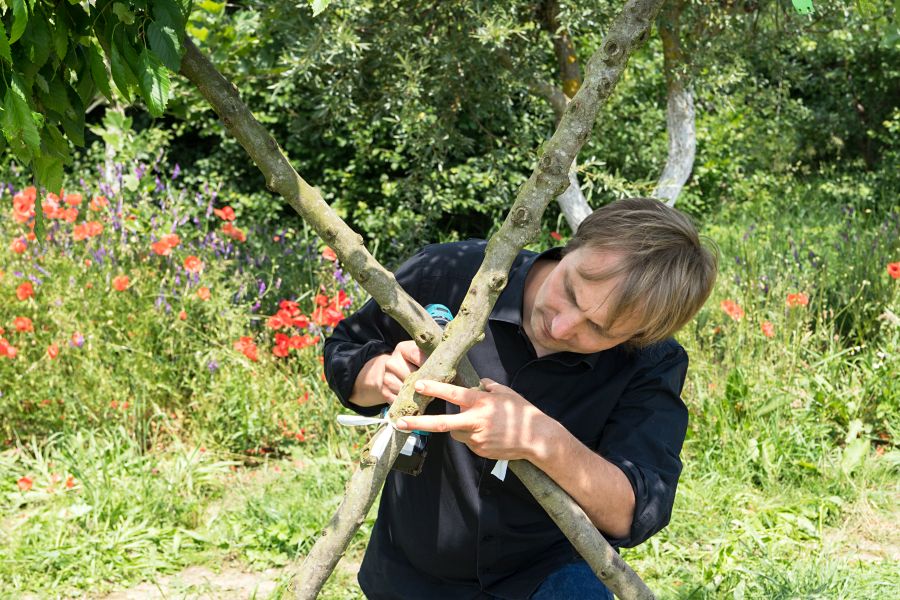Baubotanik: Prof. Ferdinand Ludwig explains how living buildings are created
Architecture that breathes

What excites you so much about using trees and other plants as construction materials?
As a rule a structure is a purely technical, precisely designed object. But a tree isn't conceived on the drawing board, it takes its shape primarily from environmental conditions. And there's no way to plan that exactly. A tree is never completed, it keeps on growing – until one day it dies. It's precisely this contrast that fascinates me. In Baubotanik we integrate plants in architecture. I started working on this dynamic in the very first semesters of my university studies. There are historical examples such as living bridges in India or the "Tanzlinde" dance linden trees in Germany: fascinating, artificially shaped trees with platforms used as a dance floor. That caught my attention, since these archaic architectural forms can be developed further and can thus offer solutions to the urgent issues we face today.
Are you thinking of climate change?
The idea is to better adapt to the impacts of climate change. Especially in cities, where a large portion of the ground is sealed with stone, concrete and asphalt. These materials heat up quickly when the temperatures rise, and people and animals in the cities suffer from heat stress. Plants have a cooling effect and provide for a better climate in the city. With Baubotanik it's not necessary to create extra space for plants, since they are integral components of the structures. Another aspect is the alienation of the human from nature: In the city people can still experience nature when for example they have the feeling that they are living in the treetops.
How do you go about planning a building that is partially made up of plants?
That's the exciting part. First you have to take a very precise look at the characteristics and requirements of the organism in order to be able to create plausible designs – even though a certain unpredictability is of course unavoidable. Here we call on the entire range of knowledge in botany, forestry and horticulture. For example, how large is the plant's growth potential and how can we control it? We also use certain technologies such as plant addition, in which the plants fuse in order to achieve the desired plant volumes faster.
Can you tell us some more about plant addition?
In projects such as the “Baubotanik Tower” or the “Plane Tree Cube Nagold" we joined several hundred young trees with one another in such a way that they merge into a single unit. Only the trees in the lowest level are planted in the ground, the rest of the trees are placed in special plant containers on several higher levels, supported by a temporary steel framework. The trunk of each respective tree is screwed together with a trunk on a higher level. Over time the bark and woody tissue fuse, resulting in a trunk structure resembling a timber-frame structure which is completely provided with nutrients from the roots of the lower trees. The steel framework is removed as soon as this structure has become stable enough to carry its own weight.
Is a building made of living plants safe?
Everything that is alive can die, so there's always some risk involved. But the closer the orientation of the architectonic concept to the natural growth patterns of the plants, the better. My goal is to improve research here at the Technical University of Munich into the growth patterns of plants, and also to develop new concepts and strategies for green architecture. Interdisciplinary collaboration is also essential here. This is evident for example in our current project Urban Micro Climate Canopy: We are letting climbing plants grow on a structure made of resin-impregnated bundles of fiberglass to create an artificial tree canopy three meters high. Here we're using computer-driven simulation methods for the design as well as robotics in constructing the framework. We've already exhibited the artificial tree canopy with great success at the Luminale in Frankfurt am Main. We will now set up the project on the test field on the campus in Weihenstephan.
More information:
The Urban Micro Climate Canopy (UMCC) project was developed by students at the TUM Architecture Research Incubator in collaboration with the Professorship for Green Technologies in Landscape Architecture (Prof. Ferdinand Ludwig, Lorenz Boigner), the TUM Chair of Building Technology and Climate Responsive Design (Prof. Thomas Auer, Daniele Santucci) and the company FibR GmbH (Moritz Dörstelmann).
Pictures for editorial use:
https://mediatum.ub.tum.de/1446722
Contact:
Prof. Dr. Ferdinand Ludwig
Technical University of Munich
Professorship for Green Technologies in Landscape Architecture
ferdinand.ludwig@tum.de
Technical University of Munich
Corporate Communications Center
- Stefanie Reiffert
- stefanie.reiffert@tum.de
- presse@tum.de
- Teamwebsite